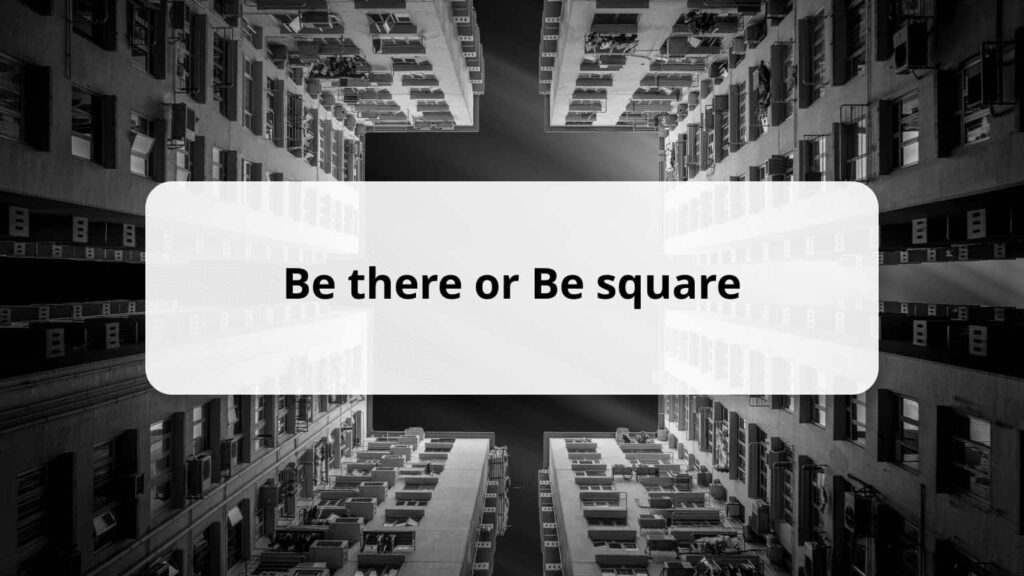Be There Or Be Square – Unpacking The Meaning And Origin!

When my friends said, “Be there or be square,” I knew missing out wasn’t an option if I wanted to join in on the laughter and fun. So, I showed up and ended up having an amazing time!
“Be there or be square” has become a staple in everyday language, playfully urging people to join events with a mix of humor and gentle pressure, lest they miss out and seem less trendy or adventurous.
In this article, we’ll explore the meaning and cultural significance of the playful phrase “Be there or be square.”
What Does “Be There Or Be Square” Mean – Most Interesting One!
“Be there or be square” is like a playful invitation with a hidden message. It just means come to the event or don’t. But the word “square” hints at being a bit old-fashioned or boring if you don’t show up. It’s like saying, “Come on, join the fun, don’t miss out!”

On a deeper level, calling someone “square” suggests they follow the rules too closely and don’t take risks. So, when you hear this phrase, it’s not just about attendance; it’s about fitting in with what’s considered cool or trendy. It adds a little social nudge, saying,
“Hey, be part of the group, don’t be left out!” Overall, “Be there or be square” mixes a simple invite with a subtle message about how we all want to be seen in social circles. It’s a fun way to talk about social expectations and what’s considered cool, making it a fun phrase we use in everyday conversations.
The Origin And Evolution Of The Phrase – Let’s Discover!
Originating from the lively jazz era of the 1940s, “be there or be square” originally referred to those unenthusiastic about jazz, branding them as lacking in excitement or appeal. As time progressed, its scope broadened beyond music to encompass all kinds of captivating or significant occasions.
The fact that it has found a place in the Urban Dictionary indicates its widespread adoption and hints at its possible inclusion in mainstream dictionaries, underlining its ongoing significance in today’s language landscape.
This evolution showcases how idiomatic expressions can transcend their initial contexts, becoming versatile tools for communication across various social settings.
The phrase’s ability to capture attention and convey a sense of urgency or desirability underscores its enduring relevance and adaptability in contemporary conversations.
Also Read: Anabel Gomez Lopez – Discover Complete Background In 2024!
Cultural Significance And Usage – You Should Know!
In casual settings, “be there or be square” holds cultural importance as a playful yet effective method to encourage involvement. Its popularity among friends and acquaintances highlights its ability to cultivate a sense of togetherness and mutual experiences.

The comedic aspect of the phrase stems from its exaggerated contrast, playfully urging individuals to make the ‘cool’ decision of joining in rather than facing the potential perception of being ‘uncool’ by abstaining.
This phrase’s charm lies in its ability to create a light-hearted atmosphere while gently pushing people towards participation. It serves as a social lubricant, enhancing camaraderie and strengthening social bonds.
By embracing the humorous nature of “be there or be square,” individuals can navigate social interactions with ease, adding a touch of fun and inclusivity to gatherings and events.
Related Idioms And Expressions – Let’s Find Out!
“Be there or be square” is a notable example among idiomatic expressions tied to coolness or adherence to social norms. It illuminates the subtle intricacies of social dynamics and the implicit expectations woven into everyday language when juxtaposed with similar phrases.
This comparison underscores the cultural significance and lasting impact of such phrases, showcasing how they resonate within society. By examining how “be there or be square” operates alongside its counterparts, we gain insights into the ways language shapes perceptions of coolness and conformity.
These idioms serve as mirrors reflecting societal values and norms, contributing to the fabric of cultural discourse.
Thus, the exploration of this phrase within the broader context of idiomatic expressions deepens our understanding of how language influences social interactions and the construction of identity, highlighting its enduring relevance and impact on communication patterns.
Also Read: Eldritch Blast 5e – Level Up Your Warlock With Eldritch Blast!
Common Misconceptions – Here To Know!
While “be there or be square” is often delivered with a light-hearted tone, it can occasionally be misinterpreted as a stern warning or even an insult. It’s crucial to clarify that the phrase is meant as a form of playful encouragement rather than a means of coercion or judgment.

Recognizing this distinction is key to fostering a more enjoyable and inclusive atmosphere when using idiomatic expressions in social interactions.
By understanding that “be there or be square” is not intended to force participation but rather to invite it playfully, individuals can engage in conversations and invitations more comfortably.
This clarity allows everyone to appreciate the humor and camaraderie embedded in such phrases without feeling pressured or misunderstood.
Ultimately, emphasizing the lighthearted nature of idioms like “be there or be square” enhances social dynamics and encourages a more positive and welcoming interaction style.
Also Read: O With Accent – Beginner’s Guidebook In 2024!
Frequently Asked Questions:
1. What does “be there or be square” exactly mean?
“Be there or be square” means you should attend an event or gathering; otherwise, you might be considered uncool or miss out on something fun.
2. How did the phrase originate and evolve?
The phrase originated in the 1940s jazz scene, originally referring to those uninterested in jazz. Over time, it expanded to encompass any exciting event, maintaining its playful yet persuasive tone.
3. Is “be there or be square” used only in casual settings among friends?
While it’s often used informally among friends, it can also be used in various settings to encourage participation or attendance.
4. Are there any similar idiomatic expressions related to coolness or conformity?
Yes, there are similar idiomatic expressions like “join the cool kids” or “get with the program,” which also imply conforming to social expectations or being seen as trendy.
5. Can “be there or be square” be considered a form of peer pressure?
While it can be seen as a form of social nudging, “be there or be square” is typically light-hearted and not meant to exert serious peer pressure. It’s more about creating a fun atmosphere and encouraging inclusivity rather than coercion.
In A Nutshell:
“Be there or be square” mixes humor, social norms, and staying cool, making it a well-loved phrase we use a lot. It’s like a fun way to invite people while gently nudging them to join in, keeping conversations lively and enjoyable.
Must Read:



